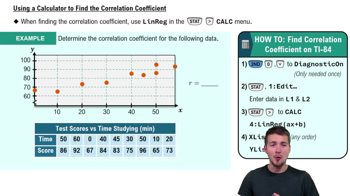Evaluate the given expression.
Table of contents
- 1. Intro to Stats and Collecting Data1h 14m
- 2. Describing Data with Tables and Graphs1h 55m
- 3. Describing Data Numerically2h 5m
- 4. Probability2h 16m
- 5. Binomial Distribution & Discrete Random Variables3h 6m
- 6. Normal Distribution and Continuous Random Variables2h 11m
- 7. Sampling Distributions & Confidence Intervals: Mean3h 23m
- Sampling Distribution of the Sample Mean and Central Limit Theorem19m
- Distribution of Sample Mean - Excel23m
- Introduction to Confidence Intervals15m
- Confidence Intervals for Population Mean1h 18m
- Determining the Minimum Sample Size Required12m
- Finding Probabilities and T Critical Values - Excel28m
- Confidence Intervals for Population Means - Excel25m
- 8. Sampling Distributions & Confidence Intervals: Proportion1h 12m
- 9. Hypothesis Testing for One Sample3h 29m
- 10. Hypothesis Testing for Two Samples4h 50m
- Two Proportions1h 13m
- Two Proportions Hypothesis Test - Excel28m
- Two Means - Unknown, Unequal Variance1h 3m
- Two Means - Unknown Variances Hypothesis Test - Excel12m
- Two Means - Unknown, Equal Variance15m
- Two Means - Unknown, Equal Variances Hypothesis Test - Excel9m
- Two Means - Known Variance12m
- Two Means - Sigma Known Hypothesis Test - Excel21m
- Two Means - Matched Pairs (Dependent Samples)42m
- Matched Pairs Hypothesis Test - Excel12m
- 11. Correlation1h 6m
- 12. Regression1h 50m
- 13. Chi-Square Tests & Goodness of Fit1h 57m
- 14. ANOVA1h 57m
4. Probability
Counting
Problem 4.4.10
Textbook Question
Radio Station Call Letters Radio and Television station call letters must begin with either K (for stations west of the Mississippi River) or W (for stations east of the Mississippi River) and must include either two or three additional letters. How many different possibilities are there?
 Verified step by step guidance
Verified step by step guidance1
Step 1: Understand the structure of the call letters. Each call letter must begin with either 'K' or 'W', which gives us 2 choices for the first letter.
Step 2: Determine the number of additional letters. The problem states that there can be either 2 or 3 additional letters. Each additional letter can be any of the 26 letters in the English alphabet.
Step 3: Calculate the number of possibilities for 2 additional letters. For each of the 2 choices for the first letter ('K' or 'W'), there are 26 choices for the first additional letter and 26 choices for the second additional letter. The total number of possibilities for 2 additional letters is given by:
Step 4: Calculate the number of possibilities for 3 additional letters. Similarly, for each of the 2 choices for the first letter ('K' or 'W'), there are 26 choices for each of the 3 additional letters. The total number of possibilities for 3 additional letters is given by:
Step 5: Add the results from Step 3 and Step 4 to find the total number of possibilities. The total number of possibilities is:
 Verified video answer for a similar problem:
Verified video answer for a similar problem:This video solution was recommended by our tutors as helpful for the problem above
Video duration:
2mPlay a video:
Was this helpful?
Key Concepts
Here are the essential concepts you must grasp in order to answer the question correctly.
Combinatorics
Combinatorics is a branch of mathematics dealing with counting, arrangement, and combination of objects. In this context, it helps determine the number of possible combinations of letters that can form the call signs for radio stations. Understanding basic combinatorial principles, such as permutations and combinations, is essential for solving problems involving selection and arrangement.
Permutations and Combinations
Permutations refer to the different ways of arranging a set of items where the order matters, while combinations refer to the selection of items where the order does not matter. In the case of radio station call letters, we need to consider how many ways we can arrange the additional letters after the initial 'K' or 'W', which directly impacts the total number of unique call signs possible.
Recommended video:

Permutations vs. Combinations
Alphabetical Constraints
In this scenario, the call letters are constrained to the English alphabet, which consists of 26 letters. This limitation affects the total number of combinations possible for the additional letters in the call signs. Understanding how to apply these constraints is crucial for accurately calculating the total number of valid call letter combinations.
Recommended video:
Guided course

Calculating Correlation Coefficient - Graphing Calculator

 7:11m
7:11mWatch next
Master Introduction to Permutations with a bite sized video explanation from Patrick
Start learningRelated Videos
Related Practice
Multiple Choice
